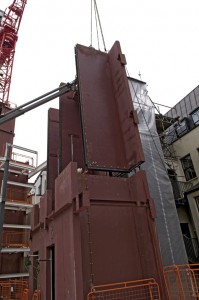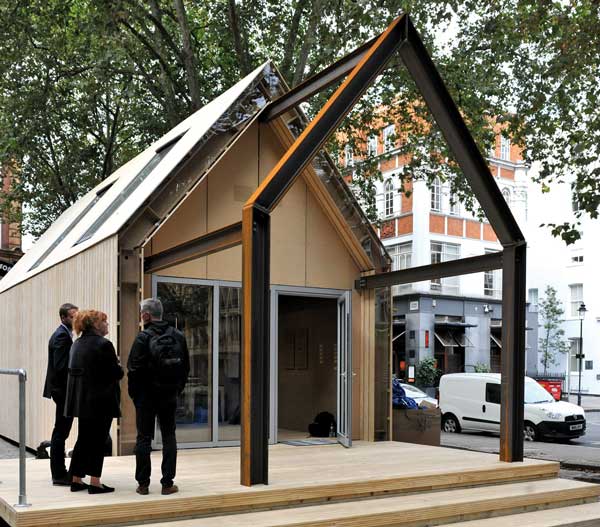Technical
Sustainable future will be built on steel
The misconception that buildings must be heavy to achieve optimum thermal mass is a myth that has been laid to rest by research showing that the optimum thickness of floor slab is routinely available in almost all steel framed buildings.
That was one of the strong messages that came across at a seminar launching the steel sector’s sustainability strategy in October, where Corus and the British Constructional Steelwork Association (BCSA) set out a clear vision for the future of sustainable development using steel construction. The commitment includes a substantial programme of research and development and cooperation on a range of initiatives with industry partners, as well as support for government and construction industry sustainability objectives.
Introducing the key aims – set out in a new publication called Sustainable steel construction: Building a sustainable future – at the London seminar Alan Todd, Corus General Manager Construction Services and Development, said: “The sector is fully committed to continuing to develop new ways of improving the sustainability performance of steel construction, and to playing a leading role in helping the industry achieve its ambitious sustainability targets.
He said: “The steel sector is united in its efforts to make steel construction even more sustainable and wholeheartedly embraces the push towards more sustainable buildings.
Steel has always provided a wide range of sustainability benefits that feed through to support all aspects of the government’s Triple Bottom Line, and we are confident that the time, effort and money being invested by the steel sector in improving those benefits will produce even greater sustainability benefits for society in the future.”
A new publication – Sustainable steel construction: Building a sustainable future – supported the event and is available from www.corusconstruction.com
Pioneering Charter demands support
Main contractors and clients are helping the drive towards improved sustainability by adopting a more sustainable approach to procurement. One way to do this is to support the BCSA’s pioneering Sustainability Charter which commits members to high sustainability performance that is regularly assessed and monitored against 12 benchmarks.
It aims to develop steel as a sustainable form of construction in terms of economic viability, social progress and environmental responsibility – satisfying the requirements of the Triple Bottom Line.
Richard Barrett, Immediate Past President of the BCSA, told seminar delegates: “You can help encourage sustainable procurement by including Sustainability Charter membership in your specifications which will help us as a sector to improve our own performance.” This scheme was launched in 2005, the first such sustainability initiative from any representative organisation.
Delegates also heard about the success of a unique Carbon Footprint Tool that had been developed on behalf of the BCSA for steelwork contractors. It is a consistent and user-friendly tool for calculating a company’s own carbon footprint as well as the embedded energy of steel products. Steelwork contractors using it can benchmark their performance, measuring improvement and producing sustainability information that can be used by customers. The BCSA uses the outputs to produce sector data and KPI’s.
New products boost for buildings
 Thanks to substantial investment in research and new product development innovative products are regularly being brought to market by the steel sector that are already having positive impacts on the sustainability performance of buildings. Corus Construction Development Manager John Dowling detailed several of these at the seminar and explained why the drive towards sustainability would increasingly involve off site construction, which most steel construction is.The Corus Photovoltaic Development for example is a £10million project to introduce Dye Sensitised Cell Technology into metal cladding for buildings, in cooperation with Australian company Dyesol and supported by the Welsh Assembly Government. Dyesol is a world leader in this technology. DSC is analogous to photosynthesis so performs better in low sunlight, poorer angles of incidence and higher temperatures than other photovoltaic technologies.Another recent development is Bi-Steel building cores (pictured below) which are six times faster to erect than concrete cores, reducing site congestion and improving safety as there is less working at height. Another development, Hi-Point roofing, is already helping fast track building programmes, being pre assembled off site or else brought to site as a kit of parts ready for assembly and quick installation.The future would increasingly belong to the low fault, quick and high quality solutions provided by off site steel based products and processes, Mr Dowling said.
Thanks to substantial investment in research and new product development innovative products are regularly being brought to market by the steel sector that are already having positive impacts on the sustainability performance of buildings. Corus Construction Development Manager John Dowling detailed several of these at the seminar and explained why the drive towards sustainability would increasingly involve off site construction, which most steel construction is.The Corus Photovoltaic Development for example is a £10million project to introduce Dye Sensitised Cell Technology into metal cladding for buildings, in cooperation with Australian company Dyesol and supported by the Welsh Assembly Government. Dyesol is a world leader in this technology. DSC is analogous to photosynthesis so performs better in low sunlight, poorer angles of incidence and higher temperatures than other photovoltaic technologies.Another recent development is Bi-Steel building cores (pictured below) which are six times faster to erect than concrete cores, reducing site congestion and improving safety as there is less working at height. Another development, Hi-Point roofing, is already helping fast track building programmes, being pre assembled off site or else brought to site as a kit of parts ready for assembly and quick installation.The future would increasingly belong to the low fault, quick and high quality solutions provided by off site steel based products and processes, Mr Dowling said.
Thermal mass myth laid to rest
 BCSA consultant Roger Pope explained that the superior performance of steel as a building framing material meant that the myth of superior thermal mass performance of concrete has been laid to rest. He said:” All the thermal mass performance required can be captured by using the steel composite flooring that is typical of modern buildings. Beyond a 100mm floor there is no advantage to thermal mass.”Dr Pope focused on several technical aspects of the excellent sustainability performance of steel. Another misconception he wanted to clear up concerned the idea of specifying steel on the basis of recycled content. Steel already has very high recycling rates due to the inherent value of scrap material, so specifying recycled steel will not actually increase the amount of steel that is recycled. In fact this could have a negative sustainability impact by diverting scrap steel to products where its use was less appropriate or potentially increasing transportation.Dr Pope argued that a fully rigorous, cradle to grave, approach that properly accounted for steels high levels of end of life recovery was needed to accurately establish the carbon emissions associated with steel use. Many of the current approaches to carbon footprinting are based on cradle to factory gate analysis due to lack of certainty on what happens to some products at the end of their life. He also pointed out that expressing figures on a per tonne basis is misleading as steel has a higher strength to weight ratio than other materials, so the embodied CO2 emissions associated with a steel framed building will often be significantly less than with other framing material options. For further details see www.corusconstruction.com/sustainability
BCSA consultant Roger Pope explained that the superior performance of steel as a building framing material meant that the myth of superior thermal mass performance of concrete has been laid to rest. He said:” All the thermal mass performance required can be captured by using the steel composite flooring that is typical of modern buildings. Beyond a 100mm floor there is no advantage to thermal mass.”Dr Pope focused on several technical aspects of the excellent sustainability performance of steel. Another misconception he wanted to clear up concerned the idea of specifying steel on the basis of recycled content. Steel already has very high recycling rates due to the inherent value of scrap material, so specifying recycled steel will not actually increase the amount of steel that is recycled. In fact this could have a negative sustainability impact by diverting scrap steel to products where its use was less appropriate or potentially increasing transportation.Dr Pope argued that a fully rigorous, cradle to grave, approach that properly accounted for steels high levels of end of life recovery was needed to accurately establish the carbon emissions associated with steel use. Many of the current approaches to carbon footprinting are based on cradle to factory gate analysis due to lack of certainty on what happens to some products at the end of their life. He also pointed out that expressing figures on a per tonne basis is misleading as steel has a higher strength to weight ratio than other materials, so the embodied CO2 emissions associated with a steel framed building will often be significantly less than with other framing material options. For further details see www.corusconstruction.com/sustainability
Improving design efficiency
David Cheshire of AECOM detailed the progress being made by the joint Corus-BCSA Target Zero project which was currently focussed on developing design guidance for sustainable schools and would be published shortly. Work had already started on warehouses, the next sector to be examined under the three year project supporting the government’s drive towards zero carbon buildings. Target Zero will also produce design guidance for a supermarket, a city centre office, and a mixed use development.
Mr Cheshire explained the approach adopted by AECOM, which involved comparing the capital cost and energy savings implications of various design options. The aim is to produce fully detailed and costed solutions that meet the emissions reduction targets.
Eddie Murphy, Mott MacDonald Technical Director, presented case studies of two recent award winning steel-framed buildings that had achieved BREEAM Excellent ratings. The 17 storey, 35,000 square metres Manchester Civil Justice Centre and Vulcan House, a new headquarters for the UK Border Agency to house 1,800 staff in Sheffield.
Monitoring both buildings since they were occupied has provided much information about how the buildings are actually used by their occupants, leading to changes in control systems. Among the valuable lessons learned to inform future designs is that building users need to be able to have some measure of control over temperatures.

















